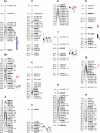Marker-based linkage map of Andean common bean (Phaseolus vulgaris L.) and mapping of QTLs underlying popping ability traits
- PMID: 22873566
- PMCID: PMC3490973
- DOI: 10.1186/1471-2229-12-136
Marker-based linkage map of Andean common bean (Phaseolus vulgaris L.) and mapping of QTLs underlying popping ability traits
Abstract
Background: Nuña bean is a type of ancient common bean (Phaseolus vulgaris L.) native to the Andean region of South America, whose seeds possess the unusual property of popping. The nutritional features of popped seeds make them a healthy low fat and high protein snack. However, flowering of nuña bean only takes place under short-day photoperiod conditions, which means a difficulty to extend production to areas where such conditions do not prevail. Therefore, breeding programs of adaptation traits will facilitate the diversification of the bean crops and the development of new varieties with enhanced healthy properties. Although the popping trait has been profusely studied in maize (popcorn), little is known about the biology and genetic basis of the popping ability in common bean. To obtain insights into the genetics of popping ability related traits of nuña bean, a comprehensive quantitative trait loci (QTL) analysis was performed to detect single-locus and epistatic QTLs responsible for the phenotypic variance observed in these traits.
Results: A mapping population of 185 recombinant inbred lines (RILs) derived from a cross between two Andean common bean genotypes was evaluated for three popping related traits, popping dimension index (PDI), expansion coefficient (EC), and percentage of unpopped seeds (PUS), in five different environmental conditions. The genetic map constructed included 193 loci across 12 linkage groups (LGs), covering a genetic distance of 822.1 cM, with an average of 4.3 cM per marker. Individual and multi-environment QTL analyses detected a total of nineteen single-locus QTLs, highlighting among them the co-localized QTLs for the three popping ability traits placed on LGs 3, 5, 6, and 7, which together explained 24.9, 14.5, and 25.3% of the phenotypic variance for PDI, EC, and PUS, respectively. Interestingly, epistatic interactions among QTLs have been detected, which could have a key role in the genetic control of popping.
Conclusions: The QTLs here reported constitute useful tools for marker assisted selection breeding programs aimed at improving nuña bean cultivars, as well as for extending our knowledge of the genetic determinants and genotype x environment interaction involved in the popping ability traits of this bean crop.
Figures


Similar articles
-
Genetic analysis of single-locus and epistatic QTLs for seed traits in an adapted × nuña RIL population of common bean (Phaseolus vulgaris L.).Theor Appl Genet. 2014 Apr;127(4):897-912. doi: 10.1007/s00122-014-2265-3. Epub 2014 Jan 19. Theor Appl Genet. 2014. PMID: 24441949
-
A Predictive Model for Time-to-Flowering in the Common Bean Based on QTL and Environmental Variables.G3 (Bethesda). 2017 Dec 4;7(12):3901-3912. doi: 10.1534/g3.117.300229. G3 (Bethesda). 2017. PMID: 29025916 Free PMC article.
-
Mapping of QTLs for morpho-agronomic and seed quality traits in a RIL population of common bean (Phaseolus vulgaris L.).Theor Appl Genet. 2010 May;120(7):1367-80. doi: 10.1007/s00122-010-1261-5. Epub 2010 Jan 19. Theor Appl Genet. 2010. PMID: 20084493
-
A Review of Angular Leaf Spot Resistance in Common Bean.Crop Sci. 2019 Jul-Aug;59(4):1376-1391. doi: 10.2135/cropsci2018.09.0596. Epub 2019 Jun 4. Crop Sci. 2019. PMID: 33343018 Free PMC article. Review.
-
Bioactive Compounds from Mexican Varieties of the Common Bean (Phaseolus vulgaris): Implications for Health.Molecules. 2017 Aug 17;22(8):1360. doi: 10.3390/molecules22081360. Molecules. 2017. PMID: 28817105 Free PMC article. Review.
Cited by
-
Identification of novel drought-tolerant-associated SNPs in common bean (Phaseolus vulgaris).Front Plant Sci. 2015 Jul 21;6:546. doi: 10.3389/fpls.2015.00546. eCollection 2015. Front Plant Sci. 2015. PMID: 26257755 Free PMC article.
-
Candidate Gene Identification with SNP Marker-Based Fine Mapping of Anthracnose Resistance Gene Co-4 in Common Bean.PLoS One. 2015 Oct 2;10(10):e0139450. doi: 10.1371/journal.pone.0139450. eCollection 2015. PLoS One. 2015. PMID: 26431031 Free PMC article.
-
Uncovering the genetic architecture of Colletotrichum lindemuthianum resistance through QTL mapping and epistatic interaction analysis in common bean.Front Plant Sci. 2015 Mar 17;6:141. doi: 10.3389/fpls.2015.00141. eCollection 2015. Front Plant Sci. 2015. PMID: 25852706 Free PMC article.
-
Punctuated distribution of recombination hotspots and demarcation of pericentromeric regions in Phaseolus vulgaris L.PLoS One. 2015 Jan 28;10(1):e0116822. doi: 10.1371/journal.pone.0116822. eCollection 2015. PLoS One. 2015. PMID: 25629314 Free PMC article.
-
Characterization of QTL and Environmental Interactions Controlling Flowering Time in Andean Common Bean (Phaseolus vulgaris L.).Front Plant Sci. 2021 Jan 14;11:599462. doi: 10.3389/fpls.2020.599462. eCollection 2020. Front Plant Sci. 2021. PMID: 33519852 Free PMC article.
References
-
- Tohme J, Toro O, Vargas J, Debouck DG. Variability in Andean Nuña common beans (Phaseolus vulgaris, Fabaceae) Econ Bot. 1995;49:78–95. doi: 10.1007/BF02862280. - DOI
-
- Gepts P, Osborn T, Rashka K, Bliss F. Phaseolin-protein variability in wild forms and landraces of the common bean (Phaseolus vulgaris L.): evidence for multiple centers of domestication. Econ Bot. 1986;40:451–468. doi: 10.1007/BF02859659. - DOI
-
- Voysest O. Variedades de fríjol en América Latina y su origen. Cali, Colombia: Spanish Centro Internacional de Agricultura Tropical; 1983.
-
- Kornegay J, White JW, Dominguez JR, Tejada G, Cajiao C. Inheritance of photoperiod response in Andean and Mesoamerican common bean. Crop Sci. 1993;33:977–984. doi: 10.2135/cropsci1993.0011183X003300050021x. - DOI
-
- CIAT. Morfología de la planta de fríjol común (Phaseolus vulgaris L.). Guía de estudio. Cali, Colombia: Spanish. Centro Internacional de Agricultura Tropical; 1984.
Publication types
MeSH terms
LinkOut - more resources
Full Text Sources

